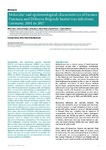Molecular and epidemiological characteristics of human Puumala and Dobrava-Belgrade hantavirus infections, Germany, 2001 to 2017
Faber, Mirko
Krüger, Detlev H.
Auste, Brita
Stark, Klaus
Hofmann, Jörg
Weiss, Sabrina
Introduction
Two hantavirus species, Puumala (PUUV) and Dobrava-Belgrade (DOBV) virus (genotype Kurkino), are endemic in Germany. Recent PUUV outbreaks raised questions concerning increasing frequency of outbreaks and expansion of PUUV endemic areas.
Aims
To describe the epidemiology of human PUUV and DOBV infections in Germany.
Methods
We conducted an observational retrospective study analysing national hantavirus surveillance data notified to the national public health institute and hantavirus nucleotide sequences from patients collected at the national consultation laboratory between 2001 and 2017. Matching molecular sequences with surveillance data, we conducted epidemiological, phylogenetic and phylogeographic analyses.
Results
In total, 12,148 cases of symptomatic hantavirus infection were notified 2001–17 (mean annual incidence: 0.87/100,000; range: 0.09–3.51). PUUV infections showed a highly variable space-time disease incidence pattern, causing large outbreaks every 2–3 years with peaks in early summer and up to 3,000 annually reported cases. Sex-specific differences in disease presentation were observed. Of 202 PUUV nucleotide sequences obtained from cases, 189 (93.6%) fall into well-supported phylogenetic clusters corresponding to different endemic areas in Germany. DOBV infections caused few, mostly sporadic cases in autumn and winter in the north and east of Germany.
Conclusions
The frequency of PUUV outbreaks increased between 2001 and 2017 but our data does not support the suggested expansion of endemic areas. The epidemiology of PUUV and DOBV-Kurkino infections differs in several aspects. Moreover, the latter are relatively rare and combining efforts and data of several countries to identify risk factors and develop specific recommendations for prevention could be worthwhile.
Dateien zu dieser Publikation


